Ronchigram Testing
Scott Prahl
April 2021
Introduction
This notebook shows output of the lenstest.ronchi library and compares it with published ronchigrams.
The surface shapes are all conics of revolution. The conic constant \(k\) defines the surface type.
less than -1 = hyperboloids
-1 to 0 = prolate spheroids
0 = sphere
greater than 0 = oblate spheroids
infinite = flat
[8]:
import numpy as np
import matplotlib.pyplot as plt
from lenstest import ronchi
from lenstest.lenstest import draw_circle
Ronchigrams of 300mm f/5 mirror with various surfaces
From https://www.telescope-optics.net/ronchi_test.htm
k=0.5 (oblate ellipsoid) to k=-1.5 (hyperboloid) for 4 lines/mm grating, and for given Ronchi grating locations inside (negative values) and outside of mirror’s center of curvature. Note how the number of intercepted lines decreases inside focus with undercorrection, and increases with overcorrection, the opposite being the case outside of focus. This is a consequence of the defocus between inner and outer mirror areas.
[9]:
#300 mm f/5 mirror, Ronchi grating 4 lp/mm
D=300
f_number = 5
lpm = 4
focal_length = f_number * D
RoC = 2*focal_length
print(" Mirror Diameter = %.0f mm" % D)
print("Radius of Curvature = %.0f mm" % RoC)
print(" Ronchi Frequency = %.0f lp/mm" % lpm)
#print(" offset = %.2f mm" % offset_from_focus)
print(" Focal Length = %.0f mm" % focal_length)
print(" F# = %.1f" % f_number)
plt.subplots(4,5,figsize=(10,10))
conics = [0.5,0.0,-0.5,-1,-1.5]
offsets = [-13.5, -6.25,6.25,13.5]
labels = ['Oblate Ellipsoid','Sphere',"Prolate Ellipsoid","Paraboloid","Hyperboloid"]
for i,offset in enumerate(offsets):
for j,conic in enumerate(conics):
plt.subplot(4,5,i*5+j+1)
x,y = ronchi.gram(D,RoC,lpm,offset,conic=conic)
plt.plot(x, y, 'o', markersize=0.1, color='blue')
plt.gca().set_aspect('equal')
plt.xlim(-D/2*1.1,D/2*1.1)
plt.ylim(-D/2*1.1,D/2*1.1)
if j==0:
plt.ylabel("off=%.2fmm"%offset)
else:
plt.yticks([])
if i==0:
plt.title("k=%.1f"%conic)
if i != 3:
plt.xticks([])
if i==3:
plt.xlabel(labels[j])
draw_circle(D/2)
plt.show()
Mirror Diameter = 300 mm
Radius of Curvature = 3000 mm
Ronchi Frequency = 4 lp/mm
Focal Length = 1500 mm
F# = 5.0
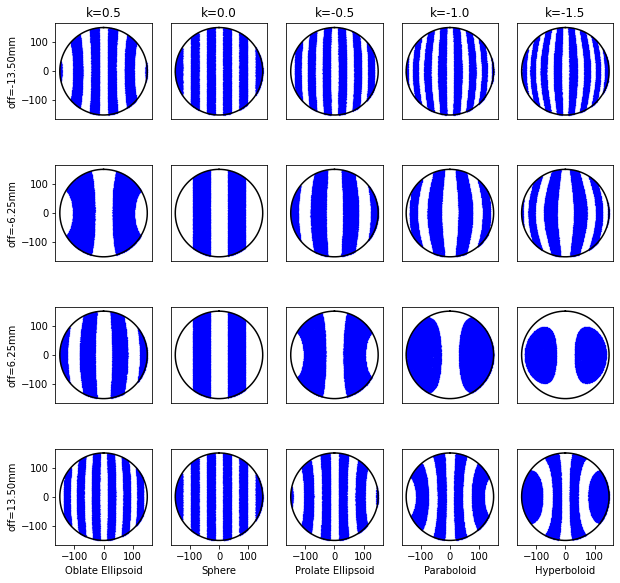
Which is reasonably close to these
Comparison with Aguirre-Aguirre
The paper
Aguirre-Aguirre, et al., “Simulation Algorithm for Ronchigrams of Spherical and Aspherical Surfaces, with the Lateral Shear Interferometry Formalism,” Optical Review, 20 (2013).
has a figures that can be matched
Aguirre-Aguirre Spherical Surface
Section 3.1
[10]:
D=128 # mm
lpm = 6.35 # lines per mm
RoC = 498.5 # mm
focal_length = RoC/2
f_number = focal_length/D
k = 0
offsets = np.array([496.5,493])-RoC
print(" Mirror Diameter %7.2f mm" % D)
print("Radius of Curvature %7.2f mm" % RoC)
print(" Focal Length %7.2f mm" % focal_length)
print(" Ronchi Frequency %7.2f lp/mm" % lpm)
print(" F# %7.2f" % f_number)
print(" conic constant K %7.2f" % k)
print()
plt.subplots(2,1,figsize=(8,8))
for i,offset in enumerate(offsets):
plt.subplot(2, 1, i+1 )
x,y = ronchi.gram(D,RoC,lpm,offset,k)
plt.plot(x, y, 'o', markersize=0.1, color='blue')
plt.gca().set_aspect('equal')
plt.xlim(-D/2*1.1,D/2*1.1)
plt.ylim(-D/2*1.1,D/2*1.1)
plt.title("offset=%.2f mm"%(offset))
plt.xticks([])
plt.yticks([])
draw_circle(D/2,color='black')
plt.show()
Mirror Diameter 128.00 mm
Radius of Curvature 498.50 mm
Focal Length 249.25 mm
Ronchi Frequency 6.35 lp/mm
F# 1.95
conic constant K 0.00
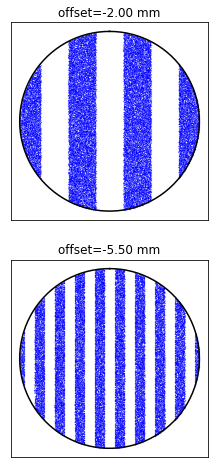
Aguirre-Aguirre Paraboloid Surface
Section 3.2
[11]:
D = 205 # mm
lpm = 6.35 # lines per mm
RoC = 2731 # mm
k = -1 # paraboloid
offsets = np.array([2723.5,2714.5])-RoC
focal_length = RoC/2
f_number = focal_length/D
print(" Mirror Diameter %7.2f mm" % D)
print("Radius of Curvature %7.2f mm" % RoC)
print(" Focal Length %7.2f mm" % focal_length)
print(" Ronchi Frequency %7.2f lp/mm" % lpm)
print(" F# %7.2f" % f_number)
print(" conic constant K %7.2f" % k)
print()
plt.subplots(2,1,figsize=(8,8))
for i,offset in enumerate(offsets):
plt.subplot(2, 1, i+1 )
x,y = ronchi.gram(D,RoC,lpm,offset,k)
plt.plot(x, y, 'o', markersize=0.1, color='blue')
plt.gca().set_aspect('equal')
plt.xlim(-D/2*1.1,D/2*1.1)
plt.ylim(-D/2*1.1,D/2*1.1)
plt.title("offset=%.2f mm"%(offset))
plt.xticks([])
plt.yticks([])
draw_circle(D/2,color='black')
plt.show()
Mirror Diameter 205.00 mm
Radius of Curvature 2731.00 mm
Focal Length 1365.50 mm
Ronchi Frequency 6.35 lp/mm
F# 6.66
conic constant K -1.00
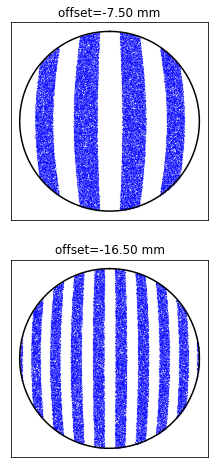
Aguirre-Aguirre Hyperboloid Surface
Section 3.3
[5]:
D = 73.2 # mm
RoC = 533 # mm
lpm = 6.35 # lines per mm
k = -3.65 # hyperboloid
offsets = np.array([532.5,529.0])-RoC # mm
focal_length = RoC/2
f_number = focal_length/D
print(" Mirror Diameter %7.2f mm" % D)
print("Radius of Curvature %7.2f mm" % RoC)
print(" Focal Length %7.2f mm" % focal_length)
print(" Ronchi Frequency %7.2f lp/mm" % lpm)
print(" F# %7.2f" % f_number)
print(" conic constant K %7.2f" % k)
print()
plt.subplots(2,1,figsize=(8,8))
for i,offset in enumerate(offsets):
plt.subplot(2, 1, i+1 )
x,y = ronchi.gram(D,RoC,lpm,offset,k)
plt.plot(x, y, 'o', markersize=0.1, color='blue')
plt.gca().set_aspect('equal')
plt.xlim(-D/2*1.1,D/2*1.1)
plt.ylim(-D/2*1.1,D/2*1.1)
plt.title("offset=%.2f mm"%(offset))
plt.xticks([])
plt.yticks([])
draw_circle(D/2,color='black')
plt.show()
Mirror Diameter 73.20 mm
Radius of Curvature 533.00 mm
Focal Length 266.50 mm
Ronchi Frequency 6.35 lp/mm
F# 3.64
conic constant K -3.65
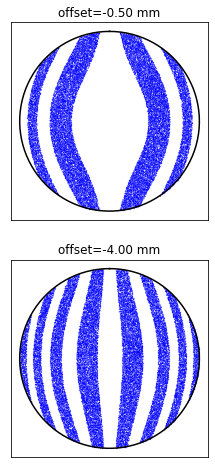
[12]:
D = 8*25.4 # mm
f_number = 7
lpm = 133/25.4*2 # lines per mm
k = -2 # hyperboloid
offsets = np.array([-192,-55,82,219,356,493])*25.4/1000 # mm
focal_length = f_number * D
RoC = 2*focal_length
print(" Mirror Diameter %7.2f mm" % D)
print("Radius of Curvature %7.2f mm" % RoC)
print(" Focal Length %7.2f mm" % focal_length)
print(" Ronchi Frequency %7.2f lp/mm" % lpm)
print(" F# %7.2f" % f_number)
print(" conic constant K %7.2f" % k)
print()
plt.subplots(2,3,figsize=(12,6))
for i,offset in enumerate(offsets):
plt.subplot(2, 3, i+1 )
x,y = ronchi.gram(D,RoC,lpm,offset,k,invert=True)
plt.plot(x, y, 'o', markersize=0.1, color='blue')
plt.gca().axis(False)
plt.gca().set_aspect('equal')
plt.title("%.2f mm from focus"%(offset))
draw_circle(D/2,color='black')
plt.show()
Mirror Diameter 203.20 mm
Radius of Curvature 2844.80 mm
Focal Length 1422.40 mm
Ronchi Frequency 10.47 lp/mm
F# 7.00
conic constant K -2.00
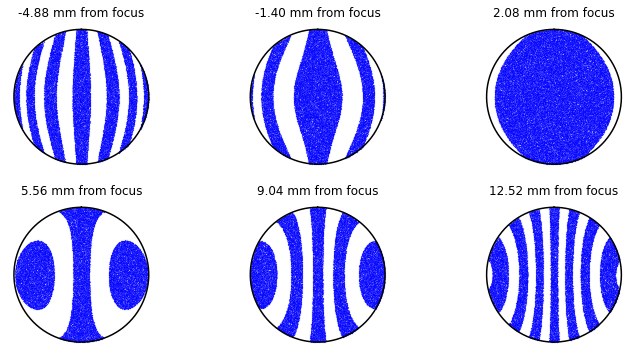
Which matches
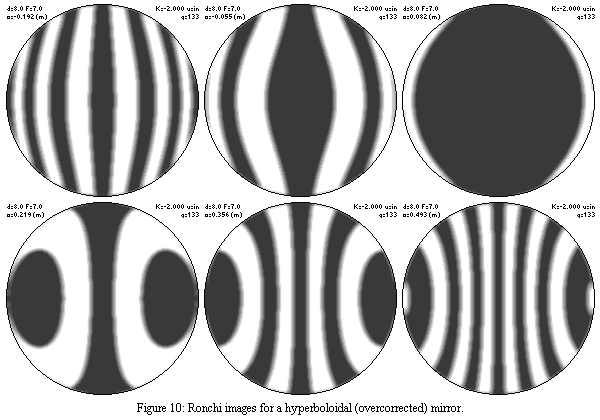
Plots of Ronchigram and Grating
One experimental challenge is getting the grating close enough, but not too close to the focus.
This shows how the mirror surface appears, as will as the size of the beam on the Ronchi ruling.
[29]:
D = 20*25.4
RoC = 160*25.4
lp_per_mm = 3
z_offset = 10
conic = -1
phi = np.radians(-45)
ronchi.plot_ruling_and_screen(D,RoC,lp_per_mm,z_offset,conic,phi=phi)
plt.show()
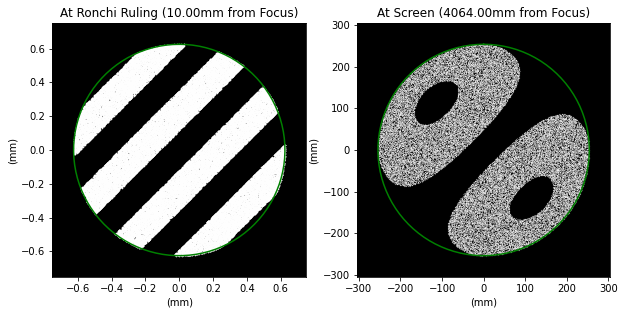
[ ]:
